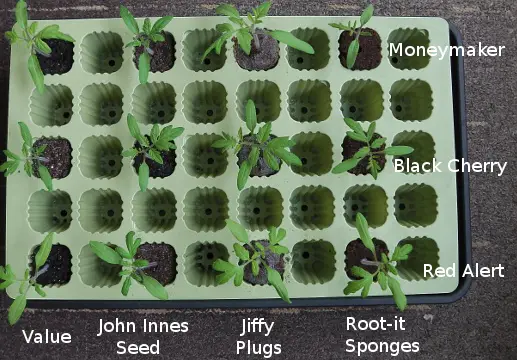As soon as I start sowing seeds, I can’t seem to stop – it becomes an obsession and logic goes out of the window!
Maybe I should start a new Facebook Group called “Seed Sowers Anonymous” and we could tell each other our seed sowing stories!
My name is Nick and my house is full of seedlings!
People have been sowing seeds for thousands of years and maybe it has become part of our natural instincts – especially at this time of the season.
Limited Space
Making the most of the space available is important if we want to get the maximum results from our efforts.
It’s amazing how even a large greenhouse can become full to overflowing in no time – especially as seedlings turn into much larger plants!
It is true that one well-grown tomato plant will produce more tomatoes than two or three tomato plants that have been struggling and competing to get enough light. A good reason to sow a bit later and not overcrowd plants.
Below is Sweet Aperitif with three stems growing in an AutoPot System.

The value in growing an extra stem (or two) on a tall indeterminate variety is that we can grow more trusses and more tomatoes!
Varieties for extra stems
Double or triple stems are best grown using vigorous cherry varieties. Our season in the UK isn’t really long enough (or good enough) for plants to produce larger tomatoes using this method because plants need a lot of sun and energy for this method.
In a good season or in a greenhouse, you could try the double stemming technique with a medium size variety.
As you can see in the photo above, there are plenty of tomatoes on each truss.
The amount of flowers and tomatoes a plant produces is related to a number of factors …
- A plant’s vigour and natural growth habits
- The amount of light it receives prior to flowering
- Its growth as a young plant – such as avoiding legginess
- The nutrients it receives and the watering method used
Tips for growing more than one stem on a tall variety ….
- Choose a vigorous cherry
- Maximise available light with light reflective surfaces and don’t overcrowd or over water, to avoid leggy growth
- Feed correctly (more on this later in the season)
- Use a method of watering that provides 24/7 access to water and nutrients
Transpiration
The Sweet Aperitif plant was grown near the opening of a polytunnel door, providing plenty of aeration.
Although the lower leaves needed a prune, which they got shortly after this photo was taken, the leaves show some cupping. It probably had a shock when it realised it had three stems!
Nevertheless, part of its success is because it was under cover, with the advantage of good air circulation around its leaves.
Plants lose moisture through their leaves – this is called Transpiration.
Without moisture loss through their leaves, plants would be unable to draw up water and nutrients through their roots.
This is especially important for tomato plants because they have to grow rapidly – from seed to fruit – all within one short season.
Seedlings and trays
Here’s a tray of seedlings in various media. Rather than using each cell, it’s good to space out the seedlings to avoid overcrowding and increase the air flow and light.

You may think I’m mad, but blowing gently on our seedlings will improve air flow, increase transpiration and the uptake of nutrients. The movement will also strengthen their stems.
Another advantage of good air flow is that it helps avoid fungal diseases and our breath contains carbon dioxide which is absorbed through the leaves and helps to increase plant growth.
I’m not suggesting we spend every waking hour blowing on our seedlings, just when we get the urge!
Of course puting them in an area where there is already good air movement or using a fan works too.
If you are interested in some of the more technical aspects of growing tomatoes such as transpiration, respiration and optimising growing conditions etc., for the price of a large bag of compost my PDF book “Technical Tomato” is available here.
Sowing Time
If you haven’t yet sown your tomato seeds, there is still plenty of time. I think the best time for seed sowing is around the middle of March to the middle of April. From late April onwards buy seedlings from the garden centre to be sure you get a crop before the end of the season.
When choosing varieties remember that, in general, the larger the tomato, the longer it takes to grow. So in a poor season, the cherry tomatoes are the ones most likely to succeed.
The Hydroponic Sow Along
The hydroponic sow along starts this week, so if you are interested, the link is here and above in the menu bar.
You can start anytime you like up to the end of April if you wish to join in. I intend it to be a fun experience and learn quite a few tips as we go along!
That’s it for this week … it’s always good to hear from you in the comments below or by email.
Have a good week and get sowing soon!
Nick
Email: [email protected]
Facebook Page: https://www.facebook.com/tomatogrowing/
Facebook Group: https://www.facebook.com/groups/216375252171863/
Links to supplies…
Tomato Seeds, Propagators, Jiffy 7 Pellets, I’m told they also have Jiffys in Wilco, Rootit Sponges, Grow Lights.
Nick’s Technical Tomato PDF Ebook

Jess Allaway
Nick, I think I’ll try double stems on a couple of black cherries. I can’t remember the advice you gave about choosing where to allow the side shoot to develop. Was it very low down the main stem or three or four up?
Nick
Hi Jess,
Allow a side shoot to develop from the lowest branch elbow, this will give you the earliest option but it doesn’t really matter if it’s the first, second or third branch.